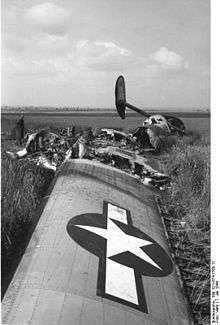Willy Unger
Willy Unger (27 March 1920 – 23 June 2005) was a Luftwaffe ace and recipient of the Knight's Cross of the Iron Cross during World War II. The Knight's Cross of the Iron Cross was awarded to recognise extreme battlefield bravery or successful military leadership. During his career he was credited with roughly 24 aerial victories—that is, 24 aerial combat encounters resulting in the destruction of the enemy aircraft.
Willy Unger | |
|---|---|
| Born | 27 March 1920 Warstein, Germany |
| Died | 23 June 2005 (aged 85) Warstein, Germany |
| Allegiance | |
| Service/ | |
| Years of service | 1939–45 |
| Rank | Leutnant |
| Unit | JG 3 JG 7 |
| Battles/wars | World War II
|
| Awards | Knight's Cross of the Iron Cross |
Career

Willy Unger was born on 27 March 1920 in Warstein. Already as a teenager, he became a skilled glider pilot. In September 1939 he joined the Luftwaffe and was accepted as an aircraft mechanic (Flugzeugmechaniker) in spite of his qualifications as pilot. Only in early 1943 Unger began his training as a fighter pilot, being incorporated into the I./Jagdgeschwader 104 (JG 104—104th Fighter Wing). In December 1943 when he completing his training was promoted to Unteroffizier.
In January 1944, Unger was appointed to serve on 12./Jagdgeschwader 3 "Udet" (JG 3—3rd Fighter Wing), commanded by Major Franz Beyer (81 aerial victories and Knight's Cross recipient). He claimed his first victory on 11 April 1944, when he shot down a B-17 Flying Fortress. Later that month, Unger added a total of eight four-engine bombers shot down. On 8 May 1944 he was shot down by defensive fire from one of the B-17s, but managed to make a successful landing. Awarded the Ehrenpokal der Luftwaffe on 21 June 1944, Unger hit two B-24 Liberator over the town of Oschersleben on 7 July 1944, claiming his 10th and 11th victories.
On 3 August 1944 he shot down two further B-24s, but his Focke Wulf Fw 190A-8 was hit again, forcing him to abandon his aircraft. In August 1944 Unger vas awarded the German Cross in Gold. On 23 October 1944, when he accounted for a total of 19 four-engine bombers, the Oberfeldwebel Willi Unger was awarded the Knight's Cross of the Iron Cross. Promoted to Leutnant (second lieutenant) in December 1944, Unger was transferred to III./JG 3 on the Eastern Front in February 1945. On this front, he would claim his last three victories of the war. At the end of March 1945, he was transferred to Jagdgeschwader 7 "Nowotny" (JG 7—7th Fighter Wing) operating the revolutionary Messerschmitt Me 262 jet fighter without claiming further aerial victories.
Willy Unger was captured by American forces in May 1945 and was released later that month. During his career he was credited with between 22–24 aerial victories in 59 missions. He recorded at least 21 victories over the Western Front, all four-engine bombers. Willi Unger died on 23 June 2005 in the town of Warstein, at 85 years of age.
Awards
- Flugzeugführerabzeichen
- Front Flying Clasp of the Luftwaffe in Silver
- Ehrenpokal der Luftwaffe (21 June 1944)
- Iron Cross (1939)
- 2nd Class
- 1st Class
- German Cross in Gold in August 1944 as Fahnenjunker-Feldwebel in the 12./Jagdgeschwader 3[1]
- Knight's Cross of the Iron Cross on 23 October 1944 as Fahnenjunker-Feldwebel and pilot in the IV.(Sturm)/Jagdgeschwader 3 "Udet"[2]
References
Citations
- Patzwall & Scherzer 2001, p. 483.
- Fellgiebel 2000, p. 347.
Bibliography
- Fellgiebel, Walther-Peer (2000) [1986]. Die Träger des Ritterkreuzes des Eisernen Kreuzes 1939–1945 — Die Inhaber der höchsten Auszeichnung des Zweiten Weltkrieges aller Wehrmachtteile [The Bearers of the Knight's Cross of the Iron Cross 1939–1945 — The Owners of the Highest Award of the Second World War of all Wehrmacht Branches] (in German). Friedberg, Germany: Podzun-Pallas. ISBN 978-3-7909-0284-6.
- Obermaier, Ernst (1989). Die Ritterkreuzträger der Luftwaffe Jagdflieger 1939 – 1945 [The Knight's Cross Bearers of the Luftwaffe Fighter Force 1939 – 1945] (in German). Mainz, Germany: Verlag Dieter Hoffmann. ISBN 978-3-87341-065-7.
- Patzwall, Klaus D.; Scherzer, Veit (2001). Das Deutsche Kreuz 1941 – 1945 Geschichte und Inhaber Band II [The German Cross 1941 – 1945 History and Recipients Volume 2] (in German). Norderstedt, Germany: Verlag Klaus D. Patzwall. ISBN 978-3-931533-45-8.
- Scherzer, Veit (2007). Die Ritterkreuzträger 1939–1945 Die Inhaber des Ritterkreuzes des Eisernen Kreuzes 1939 von Heer, Luftwaffe, Kriegsmarine, Waffen-SS, Volkssturm sowie mit Deutschland verbündeter Streitkräfte nach den Unterlagen des Bundesarchives [The Knight's Cross Bearers 1939–1945 The Holders of the Knight's Cross of the Iron Cross 1939 by Army, Air Force, Navy, Waffen-SS, Volkssturm and Allied Forces with Germany According to the Documents of the Federal Archives] (in German). Jena, Germany: Scherzers Militaer-Verlag. ISBN 978-3-938845-17-2.
- Spick, Mike (1996). Luftwaffe Fighter Aces. New York: Ivy Books. ISBN 978-0-8041-1696-1.